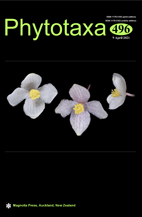Abstract
The Gracilariaceae comprises 242 mainly tropical species, including some with significant economic value for the food and pharmaceutical industry. Accurate taxonomy is crucial for the selection of species for cultivation. However, species identification is still challenging taxonomists. Nineteen species of Gracilariaceae have so far been referred to the Brazilian coast. We describe this diversity across approximately 32 degrees of latitude, using mitochondrial (COI-5P) and plastid (UPA and rbcL) markers in species delimitation analyses (ABGD and SPN). We provide phylogenetic (based on a concatenated three-genes tree and a taxa rich rbcL tree) and barcoding analyses from a broad and partially original collection combined with morphoanatomical data, including information resulting from analyses of type specimens and topotype material. We identified twenty-five specific entities occurring on the Brazilian coast, including four new species yet to be described. Spermatangial arrangements and aspects of thallus morphology were the most useful characters for species and genera delimitation, while characters based on the anatomy of the cystocarp overlap. Our morphological analyses demonstrate the lack of exclusive characters that justify the recently proposed Gracilariaceae infrafamilial categories, and therefore we use in this work the Gracilaria sensu lato genus concept. We provide descriptions, illustrations and a dichotomous key for the identification of species occurring in Brazil.

